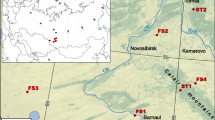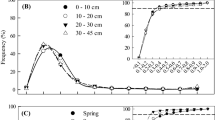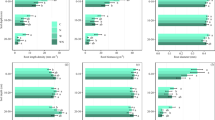Abstract
Fine and coarse root mass and fine root surface area were studied during 5 yr following the felling and burning of a tropical forest near Turrialba, Costa Rica. Five experimental ecosystems were established: 1) natural successional vegetation, 2) successional vegetation enriched by seed applications, 3) imitation of succession (built by substituting investigator-selected species for natural colonizers), 4) monocultures (two maize crops followed by cassava andCordia alliodora), and 5) a bare plot.
Fine roots grew rapidly in all treatments during the first 15 wk, at which time there were 75 gm−2 in the monoculture and 140 gm−2 in the enriched and natural successions. Subsequent growth was slower, and fine-root mass decreased during the first dry season. After 5 yr coarse root mass to a depth of 85 cm was about 800, 1370, and 1530 gm−2 in the succession, enriched succession and imitation of succession, respectively. At the final harvest, the 3.5 yr-oldC. alliodora plantation had 1000 g m−2 of coarse-root biomass. Roots <1 mm in diameter were concentrated in the upper 5 cm of soil and accounted for most fine-root surface area. Total fine-root surface area was greatest in the enriched successional vegetation and usually lowest in the monoculture.
Similar content being viewed by others
References
Alvarado A, Berish C and Paralta F 1981 Leaf-cutter ant (Atta cephalotes) influence on the morphology of Andepts in Costa Rica. Soil Sci. Soc. Am. J. 45, 790–794.
Atkinson D 1973 Seasonal changes in the length of white unsuberized root on raspberry plants grown under irrigated conditions. J. Hort. Sci. 48, 413–419.
Atkinson D 1983 The growth, activity and distribution of the fruit tree root system. Plant and Soil 71, 23–25.
Bartholomew W J, Meyer J and Landelout H 1953 Mineral nutrient immobilization under forest and grass fallow in the Yangambi (Belgian Congo) Region. Publs. Inst. Natn. Etude agron. Congo Belge, Ser. Sci. No. 57.
Berish C W 1982 Root biomass and surface area in three successional tropical forests. Can. J. For. Res. 12, 699–704.
Berish C W 1983 Roots, Soil, Litter and Nutrient Changes in Simple and Diverse Tropical Successional Ecosystems. PhD. Dissertation, University of Florida, Gainesville, Fl.
Blanton C M and Ewel J J 1985 Leaf-cutting ant herbivory in successional and agricultural tropical ecosystems. Ecology 66, 861–869.
Boring L R, Monk C D and Swank W T 1981 Early regeneration of a clearcut southern Appalachian watershed. Ecology 62, 1244–1253.
Boring L R and Swank W T 1984 The role of black locust (Robinia psuedo-acacia) in forest succession. J. Ecol. 62, 1244–1253.
Bowen G D 1980 Mycorrhizal roles in tropical plants and ecosystems.In Tropical Mycorrhizae Research. Ed. P M Kola. pp 165–190. Oxford University Press, New York, New York.
Charley J L 1983 Tropical highland agricultural development in a monsoonal climate, the utilization of Imperata grassland in northern Thailand.In Natural Resource Development and Environmental Stability in the Highlands of Northern Thailand. pp. 389–396. Chaiang Mai University and United Nations University, Thailand.
Cornforth I S 1970 Reafforestation and nutrient reserves in the humid tropics. J. Appl. Ecol. 7, 609–615.
Coutts M P 1983 Root architecture and tree stability. Plant and Soil 71, 171–188.
Coutts M P and Lewis G L 1983 When is the structural root system determined in Sitka spruce? Plant and Soil 71, 155–160.
Cox T L, Harris W F, Ausmus B S and Edwards N T 1978 The role of roots in biogeochemical cycles in an eastern deciduous forest. Pedobiologia 18, 264–271.
Deans J D 1981 Dynamics of coarse root production in a young plantation ofPicea sitchenis. Forestry 54, 139–154.
Dengo G 1962 Tectonic-igneous sequence in Costa Rica.In Petrologic Studies: a Volume to Honor A F Buddington. pp 133–161. Spec. Pub. Geol. Soc. Amer.
Dondoli C and Torres J A 1954 Estudio geoagronomico de la region oriental de la Meseta Central. Ministerio de Agricultura y Industrias, San Jose, Costa Rica.
Edwards N T and Ross-Todd B M 1979 The effects of stem girdling on biogeochemical cycles with a mixed deciduous forest in eastern Tennessee. I. Soil solution chemistry, soil respiration, litterfall, and root biomass studies. Oecologia 40, 247–257.
Ewel J 1971 Biomass changes in early tropical succession. Turrialba 21, 110–112.
Ewel J 1986 Designing agricultural ecosystems for the humid tropics. Annu. Rev. Ecol. Syst. 17, 245–272.
Ewel J, Berish C, Brown B, Price N and Raich J 1981 Slash and burn impacts on a Costa Rican wet forest site. Ecology 62, 816–829.
Ewel J, Gliessman S, Amador M, Benedict F, Berish C, Bermudez R, Brown B, Martinez M, Miranda R and Price N 1982 Leaf area, light transmission, roots and leaf damage in nine tropical plant communities. Agro-Ecosystems 7, 305–326.
Fogel R 1983 Root turnover and productivity of coniferous forests. Plant and Soil 71, 75–85.
Fogel R and Hunt G 1983 Contribution of mycorrhizae and soil fungi to nutrient cycling in a Douglas-fir ecosystem. Can. J. For. Res. 13, 219–232.
Fraser A I 1962 The soil and roots as factors in tree stability. Forestry 35, 117–127.
Fredriksen R L 1971 Comparative chemical quality—natural and disturbed streams—following logging and slash burning.In Proceedings of Symp. effects of forest land use and stream environment. pp 125–137. Oregon State University Press, Corvallis, Oregon.
Gholz H L, Hendry L C and Cropper W P Jr 1986 Organic matter dynamics of fine roots in plantations of slash pine (Pinus elliottii) in north Florida. Can. J. For. Res. 16, 529–538.
Gorham E, Vitousek P M and Reiners W A 1979 The regulation of chemical budgets over the course of terrestrial ecosystem succession. Annu. Rev. Ecol. Syst. 10, 53–84.
Greenland D and Kowal J 1960 Nutrient content of the moist tropical forest of Ghana. Plant and Soil 12, 154–174.
Grier C G, Vogt K A, Keyes M R and Edmonds R L 1981 Biomass distribution and above- and below-ground production in young and matureAbies amabilis zone ecosystems of the Washington Cascades. Can. J. For. Res. 11, 155–167.
Harcombe P A 1977a The influence of fertilization on some aspects of succession in a humid tropical forest. Ecology 58, 1375–1383.
Harcombe P A 1977b Nutrient accumulation by vegetation during the first year of recovery of a tropical forest ecosystem.In Recovery and Restoration of Damaged Ecosystems. Eds. J Cairns, Jr, K L Dickson, and E E Herricks. pp 347–378. Univ. Press of Virginia, Charlottesville, Virginia.
Hardy F 1961 The soils of the IAIAS area. Mimeo, Instituto Interamericano de Ciencias Agricolas, (IICA). Available through Centro Agronomico Tropical de Investigacion y Ensenanza (CATIE) library, Turrialba, Costa Rica.
Harris W F, Kinerson R S Jr and Edwards N T 1977 Comparison of belowground biomass of natural deciduous forests and loblolly pine plantations.In The Belowground Ecosystem: a Synthesis of Plant Associated Processes. Ed. J K Marshall. Colo. Ran. Sci. Pub. 26, 29–37.
Harris W F, Santantonio D and McGinty D 1980 The dynamic belowground ecosystem.In Forests: Fresh Perspectives from Ecosystem Analysis. Ed. R H Waring. pp 118–129. Oregon State University Press. Corvallis, Oregon.
Hart R D 1980 A natural ecosystem analog approach to the design of a successional crop system for tropical forest environments. Biotropica 12(supple.), 73–82.
Huttel C 1975 Root distribution and biomass in three Ivory Coast rain forest plots.In Tropical Ecological Systems: Trends in Terrestrial and Aquatic Research. Eds. F B Golley and E Medina. pp 123–130. Springer-Verlag, New York, New York.
Jenik J 1971 Root structure and underground biomass in equatorial forests.In Productivity of Forest Ecosystems. pp 323–331. UNESCO.
Jenik J 1978 Roots and root systems of tropical trees: morphologic and ecologic aspects.In Tropical Trees as Living Systems. Eds. P Tomlinson and M Zimmerman. pp 323–349. Cambridge University Press, London.
Johnson P L and Swank W T 1973 Studies of cation budgets in the southern Appalachians on four experimental watersheds with contrasting vegetation. Ecology 54, 70–80.
Jordan C F 1980 Nutrient leaching from agro-ecosystems in the Amazon basin, and implications for recovery of the forest.In Tropical Ecology and Development. Ed. J I Furtado. pp 553–559. International Society of Tropical Ecology, Faridabad, India.
Jordan C F 1985 Nutrient Cycling in Tropical Forest Ecosystems. John Wiley and Sons, Ltd, pp 190.
Jordan C F and Escalante G 1980 Root productivity in an Amazonian rain forest. Ecology 61, 14–18.
Klinge H 1973 Root mass estimation in lowland tropical rain-forests on central Amazonia, Brazil. I. Fine root masses of a pale-yellow latosal and giant humus podzol. Trop. Ecol. 14, 29–38.
Lawson G W, Armstrong-Mensah K O and Hall J B 1970 A catena in tropical moist semi-deciduous forest near Kade, Ghana. J. Ecol. 58, 371–398.
Likens G E, Bormann F H, Johnson N M, Fisher D W and Pierce R S 1970 Effects of forest cutting and herbicide treatment on nutrient budgets in the Hubbard Brook watershed-ecosystem. Ecol. Mono. 40, 23–47.
Likens G E, Bormann F H, Pierce R S and Reiners W A 1978 Recovery of a deforested ecosystem. Science 199, 492–496.
Marks P L and Bormann F H 1972 Revegetation following forest cutting: mechanisms for return to steady-state nutrient cycling. Science 176, 914–915.
McQueen D R 1968 The quantitative distribution of absorbing roots ofPinus sylvestris andFagus sylvatica in a forest succession. Oecol. Plant 3, 83–89.
Moir W H and Bachelard E P 1969 Distribution of fine roots in threePinus radiata plantations near Canberra, Australia. Ecology 50, 658–662.
Murphy P G and Lugo A E 1986 Structure and biomass of a subtropical dry forest in Puerto Rico. Biotropica 18, 89–96.
Nadelhoffer K J, Aber J D and Melillo J M 1985 Fine roots, net primary production, and soil nitrogen availability: a new hypothesis. Ecology 66, 1377–1390.
Nemath J C 1973 Dry matter production in young loblolly pine (Pinus taeda L.) and slash pine (Pinus elliottii engelm.) plantations. Ecol. Monogr. 43, 21–41.
Nye P H and Greenland D J 1960 Changes in the soil after clearing a tropical forest. Plant and Soil 21, 101–112.
Odum E P 1969 The strategy of ecosystem development. Science 164, 262–270.
Raich J W 1980a Carbon Budget of a Tropical Soil under Mature Wet Forest and Young Vegetation. Master's Thesis, University of Florida, Gainesville, Florida.
Raich J W 1980b Roots regrow after forest felling. Biotropica 12, 231–232.
Redhead J F 1980 Mycorrhiza in natural tropical forests.In Tropical Mycorrhiza Research. Ed. P M Kola. pp 127–142. Oxford University Press, New York, New York.
Russell A E and Ewel J J 1985 Leaching from a tropical Andept during big storms: a comparison of three methods. Soil Sci. 139, 181–189.
Sanford R L Jr 1987 Apogeotropic roots in an Amazonian rain forest. Science 235, 1062–1064.
Sanni S O 1976 Vesicular-arbuscular mycorrhiza in some Nigerian soils: the effect ofGigaspora gigantea on the growth of rice. New Phytol. 7, 763–774.
Santantonio D 1982 Production and Turnover of Fine Roots of Mature Douglas-fir in Relation to Site. Ph.D. Dissertation. Oregon State University, Corvallis, Oregon.
Santantonio D and Hermann R K 1985 Standing crop, production, and turnover of fine roots on dry, moderate, and wet sites of mature Douglas-fir in western Oregon. Ann. Sci. For. 42, 113–142.
Santantonio D, Hermann R K and Overton W S 1977 Root biomass studies in forest ecosystems. Pediobiologia, Bd 17, 1–31.
Schier G A and Zasada J C 1973 Role of carbohydrate reserves in the development of root suckers ofPopulus tremuloides. Can. J. For. Res. 3, 243–250.
Singh K P, Lauenroth W K, Hunt H W and Swift D M 1984 Bias and random errors in estimators of net root production: a simulation approach. Ecology 65, 1760–1764.
Singh K P and Singh R P 1981 Seasonal variation in biomass and energy of small roots in tropical dry deciduous forest, Varanasi, India. Oikos 37, 88–92.
Srivastava S K, Singh K P and Upadhyay R S (1986) Fine root growth dynamics in Teak (Tectono grandis Linn. F.). Can. J. For. Res. 16, 1360–1364.
St John T V 1983 Response of tree roots to decomposing organic matter in two lowland Amazonian rain forests. Can. J. For. Res. 13, 346–349.
Stark N and Spratt M 1977 Root biomass and nutrient storage in rain forest Oxisols near San Carlos de Rio Negro, Trop. Ecol. 18, 1–9.
Statistical Analysis System Institute (SAS) 1979 A user's guide to SAS. SAS Institute, Raleigh, North Carolina.
Steel R G and Torrie J H 1960 Principles and Procedures of Statistics. McGraw-Hill, New York, New York.
Tew R K 1970 Root carbohydrate reserves in vegetative reproduction of Aspen. For. Sci. 16, 318–320.
Tosi J A 1969 Mapa ecologia de Costa Rica. Centro Cientifico Tropica, San Jose, Costa Rica.
Tyron P R and Chapin F S III 1983 Temperature control over root growth and root biomass in taiga forests. Can. J. For. Res. 10, 523–529.
Uhl C and Murphy P 1981 A comparison of productivities and energy values between slash and burn agriculture and secondary succession in the upper Rio Negro region of the Amazon Basin. Agro-Ecosystems 7, 63–83.
Uhl C, Clark K, Clark H and Murphy P 1981 Early plant succession after cutting and burning in the upper Rio Negro region of the Amazon Basin. J. Ecol. 69, 631–649.
Vitousek P M and Reiners W A 1975 Ecosystem succession and nutrient retention: a hypothesis. Bioscience 25, 376–381.
Vogt K A, Edmonds R L and Grier C C 1981 Seasonal changes in biomass and vertical distribution of mycorrhizal and fibrous-textured conifer roots in 23- and 180-year-old subalpine (Abies amabilis) stands. Can. J. For. Res. 11, 223–229.
Vogt K A, Grier C C, Meier C E and Redmonds R L 1982 Mycorrhizal role in net primary production and nutrient cycling inAbies amabilis ecosystems in western Washington. Ecology 63, 370–380.
Vogt K A, Grier C C and Vogt D J 1986 Production, turnover and nutrient dynamics of above- and below-ground detritus of world forests. Adv. Ecol. Rev. 15, 303–377.
Wells C G and Jorgensen J R 1975 Source-sink relations and the partition of assimilates in the plant.In Symposium on the Impact of Intensive Harvesting on Forest Nutrient Cycling. pp 212–230. State University of New York, Syracuse, New York.
Author information
Authors and Affiliations
Rights and permissions
About this article
Cite this article
Berish, C.W., Ewel, J.J. Root development in simple and complex tropical successional ecosystems. Plant Soil 106, 73–84 (1988). https://doi.org/10.1007/BF02371197
Received:
Revised:
Issue Date:
DOI: https://doi.org/10.1007/BF02371197




